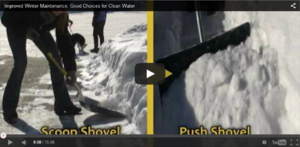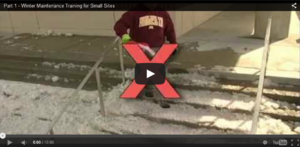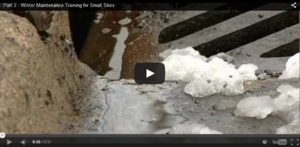
Educational resources for Smart Salting (S2)
Salt that is applied to our roads, parking lots, and sidewalks ends up in our lakes, streams, and wetlands, negatively impacting those water resources. Salt has other negative impacts, such as harming vegetation, including turf, and altering the process of infiltration into soil.
This page provides information on education resources for salt management. Included are links to fact sheets, websites, and videos.
Contents
Residents



- 9 Mile Creek Watershed district fact sheet - this fact sheet offers some background information on effects of salt and a 4-step process for managing ice in residential settings
- MPCA Salt Pollutes postcard - offers tips on ways to reduce salt use. Print and distribute to residents and local businesses.
Building entrances and sidewalks
The MPCA worked with the Mississippi Watershed Management Organization, the University of Minnesota, and Fortin Consulting to produce a 20-minute video that introduces best practices for winter maintenance of small spaces such as sidewalks, entryways, and steps. Guidance includes deicer material selection and application rates. Links to Part 1 and Part 2 of this are shown to the right.
Hire certified contractors
If you hire out snow removal for your property, choose a contractor who is certified by the state in Snow and Ice Control Best Practices or encourage them to become certified. This list of certified practitioners is maintained by MPCA and can be accessed as an File:Road salt training certificate holders.xlsx.
Many local lakes and streams have elevated levels of chloride, a common ingredient in road salt. In some cases, the chloride contamination is high enough to impact or even kill fish and other aquatic life. Winter snow and ice practices have been identified as the primary source of this chloride. Certified contractors have taken a training on how to mitigate the effects of de-icing materials on the environment, without compromising safety or effectiveness.
Voluntary certification in Snow and Ice Control Best Practices from the MPCA is given to individuals who
- attended voluntary training,
- complete and pass the associated test, and
- agree to voluntarily apply best management practices to reduce chloride impacts.
*Smart Salting (S2) training program
- Snow and Ice Control Material Application (CTAP) - This Circuit Training and Assistance program (CTAP) workshop helps determine the correct chemical and proper application rates based on the weather and pavement temperature for using salt and sand most effectively.
- Clear Roads Winter Maintenance Newsletter - Clear Roads produces a quarterly newsletter that captures the latest research and news on winter maintenance technology and practices within the U.S. and around the world. Each E-newsletter compiles links to recent reports, guidance documents, news articles, and research updates from state DOTs, universities, the Transportation Research Board and the Federal Highway Administration.
Related pages
- Overview and impacts of road salt and deicers
- Smart Salting Best Management Practices (BMPs)
- Management tools
- Smart Salting (S2) training program
- Educational resources for Smart Salting (S2)
- Cost-benefit considerations for Smart Salting (S2) and road salt winter maintenance
- Case studies for Smart Salting (S2) and road salt winter maintenance
- Chloride TMDL projects
- Links for Smart Salting (S2) and road salt winter maintenance
- References for Smart Salting (S2) and road salt winter maintenance